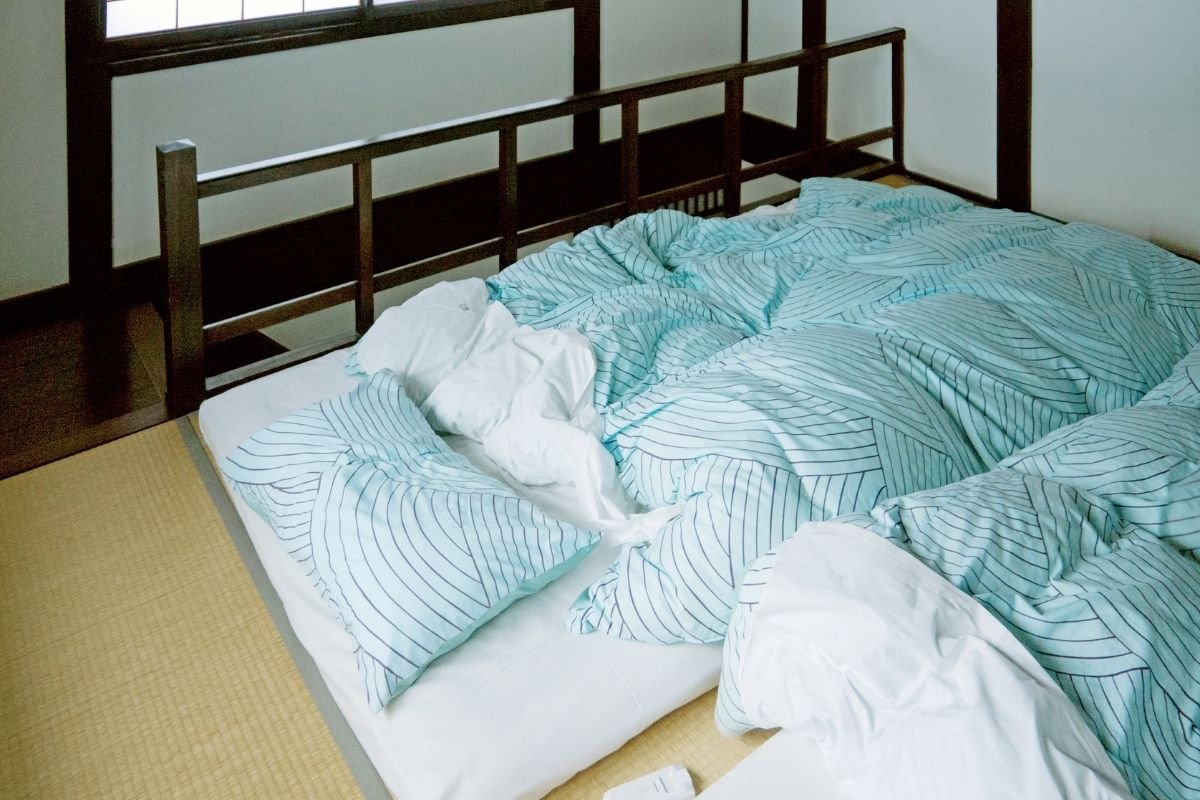Futon mattresses are becoming increasingly popular all around the world. They offer great comfort and support, but they also come at a price.
But what exactly is a futon? And how do you care for your futon?
In this article, we’ll explore what a futon mattress is (see also ‘Are Futons Good For Your Back?‘), and how you look after it properly.
What’s A Futon?

The concept of futon comes from Japan where a futon was traditionally the word for a round mat or cushion which was filled with wool or leaves.
The full futon set for sleeping in Japan consists of a duvet and a mattress. This was placed on a tatami mat that covered the floor. The futon became an important part of Japanese life.
It could be used as a bed when guests came to stay. It could easily be rolled up and stored away during the day, and it was even sometimes used as a seating area.
A futon mattress has been around since the early 1900s, but it wasn’t until the 1960s that it started to become more widely available.
Most people didn’t know what a futon was until the 1980s.
Today, a futon mattress is a type of bedding that consists of a thick cushion filled with foam or other materials.
Futons are also often used as extra seating space in living rooms, bedrooms, or dormitories.
How To Care For A Futon Mattress?
A modern futon mattress needs a little more maintenance and care than other mattresses.
Due to its traditionally natural materials, moisture easily builds up inside a futon mattress. This can lead to mold growth and mildew.
In addition, moisture also compresses the fibers inside the futon making it uncomfortable to sleep on. As a sleeper naturally releases sweat and moisture, this can cause the futon to become damp.
Here are some tips on how to care for your futon mattress properly.
Rotate Your Futon Mattress Frequently
Similar to a normal mattress, you should rotate your futon mattress every few months. This will only help prevent mold from growing in your futon but also ensures your futon mattress is used on both sides.
To do so, simply flip your futon mattress over onto its side, and after a few months back again. Make sure to place the futon mattress on a flat surface first before flipping it over.
If you have an old futon mattress, you may need to rotate it a little more often as the fibers inside the mattress may compress quicker.
Air Your Futon Mattress
When you wander along the streets in Japanese towns, you often see futon mattresses and duvets airing outside.
This has a good reason. The best way to prevent moisture build-up in a futon mattress is to air it regularly.
You can open all windows in your home and let the fresh air flow into your room. However, the best way to air your futon set properly is to hang it outside.
Wash Your Futon Mattress
Depending on the type of material your futon is made of, you may be able to wash the futon duvet.
However, the majority of futons are made of cotton and other natural materials which are best washed by hand.
Simply soak the entire futon in warm water, and then gently squeeze out the excess water using a clean towel.
Afterward, lay the futon down on a dry surface and allow it to air dry completely. You can use a hairdryer if needed.
Put Your Futon Into The Sunlight
Another important thing to remember when caring for your futon mattress is to put it outside in the sunlight.
As mentioned earlier, futons are typically made of natural materials such as cotton, silk, and linen. These fabrics absorb moisture very quickly.
Placing the futon in the sunlight will help the moisture evaporate, and it will dry the futon much quicker.
Use A Mattress Protector
As with any other mattress, you should always use a mattress protector when sleeping on your futon.
The mattress protector will protect your futon mattress from moisture and other liquids.
In addition, it protects against dust mites, allergens, and bacteria that could potentially grow on your futon mattress.
Also, a futon protector is much easier to clean and wash than the entire mattress.
The mattress protector should be placed directly on top of the futon mattress. If you cannot find one at your local store, you can buy them online.
How To Clean A Futon

The best way to keep your futon clean is by using the methods described above. If your futon mattress needs a more thorough clean, then this is not difficult.
All you need is a soft cloth or sponge, mild soap and water, and a vacuum cleaner.
Remove The Futon Cover
Start by removing the cover from your futon mattress. If you use a mattress protector to keep moisture away from your futon, then also remove this.
Washing The Futon Mattress
Generally, your futon mattress is too large to put inside a conventional washing machine. This means that you will only be able to clean certain spots of the mattress.
These may be mold stains or damp spots that you might want to clean up.
To do so, take a damp cloth or sponge and wipe away any dirt or stains. Make sure to get rid of any loose threads or debris.
Next, pour some mild soap onto the wet area and rub it around until it gets foamy. Then rinse off the foam with clean water.
Finally, shake the excess water from the futon mattress and place it back onto its base.
Vacuum The Futon
Once you have cleaned the futon mattress, you can now vacuum it. You can either use an upright vacuum cleaner or a handheld vacuum.
Go over the futon thoroughly to ensure you don’t miss a spot. While the vacuum cleaner will not remove everything, it can remove most of the dust and any mites.
Dry The Futon
Any damp spots must dry properly before you use the futon again. Place the futon outside and allow it to air dry in the sunshine.
For this reason, it’s best to clean your futon mattress on a day when it’s not raining.
Conclusion
Futon mattresses are great because they provide comfort, but they’re also relatively easy to care for.
You just need to follow the above simple steps to keep your futon mattress looking new and fresh.
- What Is a Maiko? - July 13, 2025
- What Does Domo Arigato Mean? - July 12, 2025
- What Does Naruto Mean? - July 12, 2025









